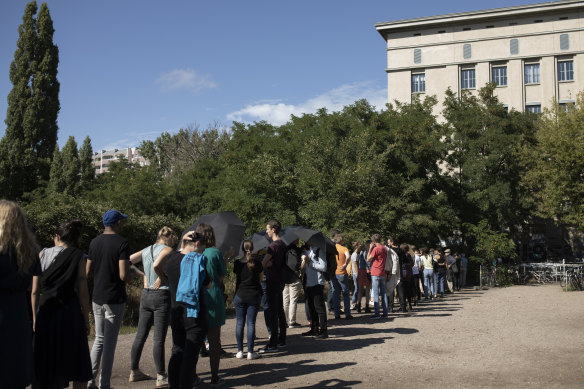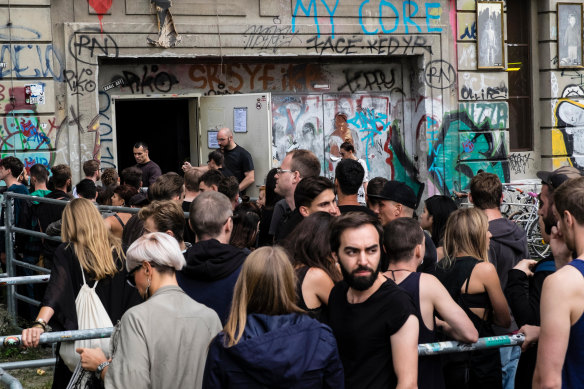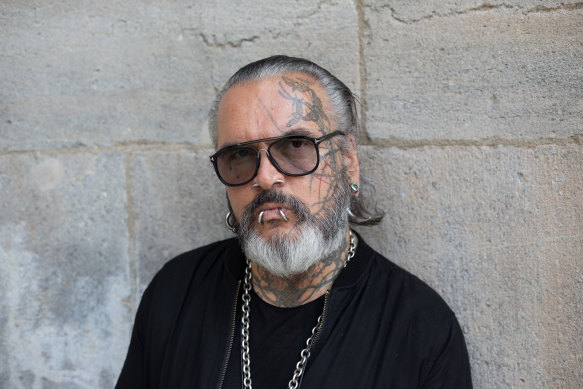This was published 1 year ago
I tried to get into Europe’s most notorious nightclub (and failed)
I’m wearing bike shorts and a T-shirt I’d typically reserve for bed. My hair is tied up in “space buns” – two knots on either side of my head, a hairstyle I associate with Y2K rave culture. I have a bum bag slung across my body. I’ve never worn a bum bag in my life until today. Everything is black, except for my sneakers – old, scuffed Converse. I’m about to try to get into Berghain, Berlin’s most exclusive, most notorious nightclub. With whatever I packed in my suitcase.

Hopefuls will queue for as long as six hours to get into Berghain.Credit: Getty Images
Berghain is a place of myth and legend. Only those who have made it through the cavernous entry truly know what lies inside, thanks to a strict no-photos policy and reviews that, while attempting to describe the frenetic energy, still give a “you had to be there” mystique.
Spend one minute on Google, and you’ll find mountains of detailed advice about how to make it past Berghain’s bouncers and through its doors. Sven Marquardt, the club’s most famous guard, has given several interviews on this topic but has remained vague. “It’s subjective,” he told GQ in 2015. “You always want friction, though. That’s the theme in any good club: diversity, friction.”
Even with the very real chance of being denied entry, people will queue up at Berghain for hours. The night I decide to try my luck, the queue at one point is six hours long. At least 50 per cent of people are being turned away at the door, and there is no correlating factor that connects them. Just as Marquardt said, it feels subjective.
A woman in head-to-toe latex bondage? Waived toward the exit. A woman in a denim mini skirt and white linen shirt laughing with her boyfriend? Let through. A cool-looking solo clubber in head-to-toe black with scuffed sneakers? Sent on his way.

On the morning of my visit, about half the people queuing are denied entry.Credit: Alamy
Housed inside a heating plant built during the post-war socialist construction boom that saw Stalinallee (now Karl-Marx Allee) and its imposing apartment complexes rise from the ashes of a war-torn city, right in the heart of what was once East Berlin, Berghain has an apocalyptic feel from the moment you turn left, past the quiet fuel station, and begin the trek toward its snake-like queue.
Aside from the throbbing techno bass emanating from its walls, it could still be a relic of the past. A bent and broken chain fence lines one side, an abandoned lot of overgrown grass and ancient trash beyond its borders. There is a small, run-down kiosk selling drinks for those who have made the pilgrimage. Its brutalist cement exterior looms intimidatingly over we hopefuls.
For all its aura of exclusivity, Berghain is really about inclusivity. Founders Norbert Thormann and Michael Teufele began their careers as party promoters in 1992, starting a gay fetish night called Snax. Seven years later, they opened their first club, Ostgut, which was open to all, but maintained the focus on sexual freedom and the celebration of queer culture, which remains part of Berghain’s soul to this day. Yes, it’s the techno capital of the world. Still, it’s more than that – it’s a place, somewhat ironically, striving to be free of judgement and maintaining an environment behind its doors that allows party-goers freedom of expression in a cocoon of safety.
Not that I’d know.
My palms are sweaty an hour before I’m even at the front of the queue. I’ve been attempting to look nonchalant since the moment I arrived. It’s 5am on Sunday, and the sky is turning a candy-floss pink, which feels at odds with the silent, shuffling mass of partygoers surrounding me.

Berghain’s famous bouncer Sven Marquardt.Credit: Getty Images
As I near the front, the mass thins out, filtered through a maze of metal not unlike a cattle pen that turns it into a two-by-two line. People push in, which enrages me, but the first rule anyone will tell you about Berghain is that you never, ever make a scene in the queue. So I silently seethe after my hours of waiting.
One man is letting everyone pass him. I watch curiously. It seems he’s decided Berghain’s entry is algorithm-based. He’s waiting for the right moment to rejoin the queue for the best chance of getting in.
Suddenly, I’m two groups from the front. I’m entering on my own, so I feel positive about my chances. Surely it’s a bit of a numbers game, like the man waiting in the wings is thinking? I conceal my anxiety as best I can – a born people-pleaser, I have to control the urge to smile beatifically at the bouncer (not Marquardt, but just as imposing in black leather and sunglasses).
Instead, I aim for “bored-looking techno fan”. I have no idea what I’m doing. For starters, I don’t know what to do with my arms. Cross them? That feels arrogant. Hold my bum bag? Let them flop by my side? I go for the bum bag route. Then there’s the stance. The people in front of me are sent inside. They were just standing … normally? I’m over-thinking this. I’m next up, but the bouncer is ignoring me, chatting to someone he knows who is exiting the club. I lean on one hip, which feels the least unnatural and the most cool, calm and collected.
When the bouncer turns around, I make what I assume was an unforgivable mistake. I look into his eyes. I’m almost positive my desperation is right there all over my face. I’m sure he can see my eagerness to be let in.
To his credit, he shakes his head solemnly, conveying an apology – nothing against you, but you’re not coming in tonight. After waiting two hours, I’m unceremoniously walking off into the neighbouring park.
As a chronically analytical person, I spend the next few hours lying in bed, wired from the experience and unable to sleep, going over every move I made. What went wrong? Was it my outfit? Granted, it wasn’t the best, but I had read that you’re more likely to get into Berghain if you look like you want to have a big, sweaty night of dancing. Was it the hair? I didn’t see any other space buns. Maybe they’re less Y2K-core than I thought.
I reflect on other people in the queue, who got in and didn’t. It hit me – the reason I was rejected from Berghain is because I didn’t appear like I was meant to be there.
I am not a naturally calm, self-assured person. I am a nervous person, often battling with what others think of me, always anxious in situations outside of my comfort zone. I’d make a terrible spy. I’d practically blurt out that I was undercover within minutes.
So when I got to the front of that queue, I believe the bouncer could sense my nervous tension. I think I wanted it too much. And if you think about how many tourists would attempt entry into Berghain just to ogle other punters, desperate to tick “got into Berghain” off their bucket list, you can understand why they would want to keep the crowd as low-key as possible. If freedom of expression is at the core of Berghain’s ethos, a gaggle of eyeballers isn’t exactly going to support that.
So my theory is this: to get into Berghain, you must be chill. Not try to be chill, actually be relaxed and at ease. Ultimately, the one common thread I noticed was that those who got in seemed, from what I could tell, like people who believed they would get in. No darting glances or “what do I do with my hands” behaviour. Just cool, calm, confident.
In his memoir Die Nacht Ist Leben, Marquardt seems to confirm this. “I don’t mind letting in the odd lawyer in a double-breasted suit with his Gucci-Prada wife. If they make a good impression, let them in. We also take guys in masks and kilts, or Pamela Anderson blondes in run-of-the-mill high-street outfits who tag along with bearded blokes, licking the sweat off each others’ armpits.”
“That, for me, is Berghain.”
Berghain is located at Wriezener Bahnhof, near Berlin’s Ostbahnhof. It opens from 11.59pm Friday to 7am Saturday then from 11.59pm Saturday until 6am Monday. Some special events occasionally take place during the week. The entrance fee varies but generally starts from €20.
Sign up for the Traveller Deals newsletter
Get exclusive travel deals delivered straight to your inbox. Sign up now.